Parks | April 20, 2020
Understanding Sherman Creek's Living Shoreline
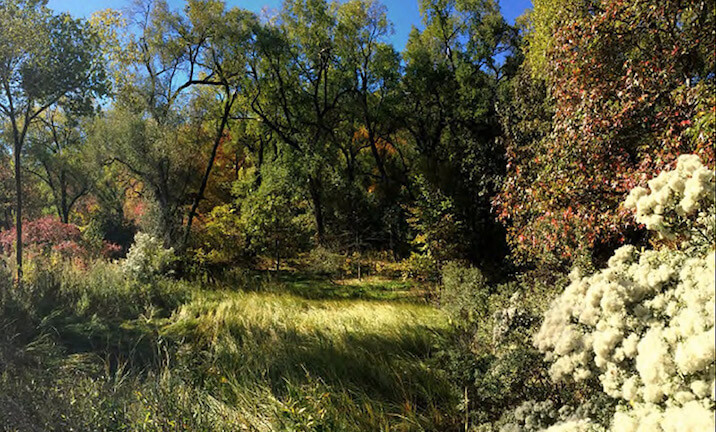 Swindler Cove at Inwood’s Sherman Creek Park.
Swindler Cove at Inwood’s Sherman Creek Park. We often hear about New York’s vulnerability as climate change churns: sea levels rise, the heat island effect intensifies, Hurricane Sandy was just a warm up. But is it possible to imagine an environmentally resilient city that lessens climate change’s consequences instead of contributing to or being subject to them?
This is one of the questions we’re investigating with our living shoreline work at Inwood’s Swindler Cove, which began in 2017 as part of an effort to protect and expand a small patch of salt marsh–the last remaining ecosystem of its kind in Manhattan.
This year, the plan is for Swindler Cove to become a multifaceted example of what an environmentally and socially resilient New York City waterfront could look like, including installing an oyster reef, adding more wetland plantings, seeding ribbed mussels, and enhancing its use and accessibility as a public park.
While we adapt installation plans under COVID-19, and in light of the 50th Anniversary of Earth Day, we caught up with our Director of Landscape Architecture Filomena Riganti and Director of Northern Manhattan Parks Jason Smith to learn more about what a living shoreline is and why New York Restoration Project (NYRP) is uniquely positioned to install one at Swindler Cove.
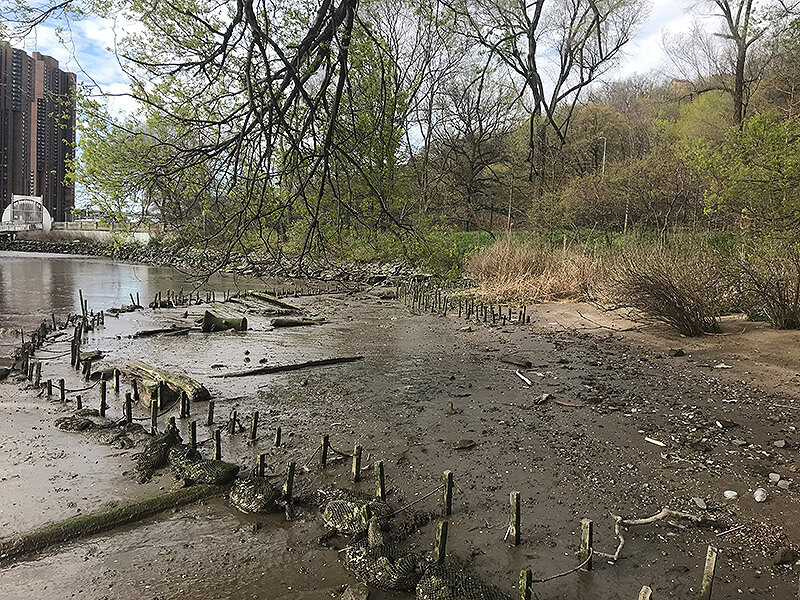
Swindler Cove at Inwood’s Sherman Creek Park.
What’s a living shoreline?
Fiolmena Riganti: The goal of a living shoreline is to achieve wetland restoration in order to stabilize and adapt the shoreline. Living shorelines usually implement the most natural and lightest environmental footprint possible. On one extreme end, that would probably just include plants, and then you can intensify the project with other materials as needed.
Jason Smith: Living shorelines are a spectrum and while our project incorporates some engineered materials like concrete in the intertidal zone, from our perspective, it really doesn’t negatively impact the natural processes on site at all.
In fact, those engineered components should increase the natural function of the site. Our shoreline will continue to be very porous and have a large intertidal zone and a lot of habitat, and so we think it’s really the best example of what a living shoreline can be. It wouldn’t work for every site in New York, but for sites like ours, which are moderately threatened by storms and wave energy, we think it’s a really good example of a living shoreline.
Why install a living shoreline as opposed to, say, build a sea wall?
FR: A healthy, functioning shoreline is like a natural sponge. When a storm surge comes, there may be a temporary flooding, and there may be some disruptions as well, but usually they are short term. Once the water recedes, healthy shorelines can heal. In contrast, a seawall doesn’t allow a place for water to go except up, which results in what just going above the seawall, causing flooding while also preventing the water from receding. It ultimately damages the infrastructure of the city, which is, in theory, what the seawall is intended to protect.
The advantage of building a wall over a living shoreline, however, is that it’s a one-and-done project. It’s an expensive installation, but once it’s done, you can kind of forget about it, and historically, that’s what the city has done. I don’t know what percentage of Manhattan shoreline is a wall, but it’s really high. If you are the city or an investor, you’re willing to invest in something, but you want to only do it one time, which is the appeal of a wall.
Risk is a big part of doing a living shoreline. Frankly, I don’t know if our living shoreline is going to be successful, but we think it’ll be at least partially successful. There’s also inevitably going to be some failure, which will be a learning experience for us.
That requires not just taking the time to learn the site initially before you do the project, but also after the product is installed, observing it and maintaining it. That’s a big investment of time, which is what a lot of parties don’t want to do.
JS: The difference between a living shoreline and a seawall is a fundamentally a different relationship to the landscape. Because we at NYRP are regularly at Swindler Cove monitoring, evaluating, and adapting our design, it’s not that kind of one-and-done approach. It is demanding of our time to be at Swindler Cove, but it is also a privilege and one that I’d like to see parks workers and land stewards across the city have. I would like more people to be able to monitor their shorelines and feed that information back into adaptation and design. It’s really turning the power relations around how shoreline design is done, which is somewhat idealistic, but it’s also really practical.
The reality of capital investment in the urban landscape that is really hard to successfully implement a project like a living shoreline. That’s actually where I think a nonprofit group like NYRP, with a long history of stewardship, can play a really important role with a very different kind of relationship.
NYRP also has a real history of trusting the communities we work with. We build really beautiful things and let the community use them. This goes against the grain of how communities, particularly in lower income areas, are not accorded a great deal of respect in how spaces are designed and that includes shoreline accessibility.
Too many urban waterways are fenced off out of a fear for safety, and simply being able to have kids walk up to the water is not something that most parks are entirely comfortable with. We’re seeing it more and more though, even though it’s still one of the big sticking points for moving this kind of work forward. It’s a tough fight where I wonder if we can really help push the envelope because we do have a tradition of really trusting and investing in communities where that’s not always done.
That sounds like a very bold statement, but I think it’s true, and that’s really, to me, what’s special about the nature NYRP’s general approach, living shoreline or otherwise.
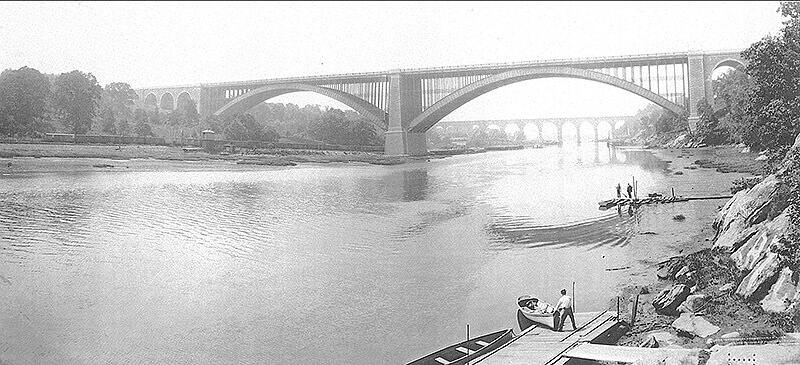
Harlem River shoreline in 1890. Credit: William Henry Jackson.
What are the environmental benefits of a living shoreline?
FR: The benefits of living shoreline are really the benefits of marsh, which include flood control, storm protection, sediment retention, nutrient cycling, water purification, and biodiversity. The goal of a living shoreline is to restore this ecological functionality of a marsh habitat on the shoreline.
JS: We know that the majority of our shoreline and a lot of the interior of Manhattan was once filled with wetlands. They’re federally protected and recognized as valuable natural resources because we’ve lost so many, and we continue to lose a lot every year to climate change.
Nutrient cycling actually stores a lot of carbon. Some people are refer to it blue carbon, in contrast to the carbon that we can store on land—both of which help mitigate climate change.
Wetland nutrient cycling also helps address combined sewer overflows, which is one of the largest environmental problems in New York City. When it rains, the city’s waste water management system releases untreated sewage into the harbor, which then causes an excess of nitrogen in the water. With research we’re doing on site at Swindler Cove, which sits on a polluted waterway like the Harlem River, we’re finding that our wetlands are removing a great deal of nitrogen.
Wetlands also create habitat for wildlife. When the grasses decompose, all that organic material flows back out into the larger surrounding estuary and is really the foundation of the harbor’s aquatic food chain. Marshes are really powerhouses of biological productivity.
The biggest kind of ecosystem service that I see in wetlands though, which we’re protecting with our living shoreline installation, is actually having what we call a “soft shoreline” where the water is accessible, which is incredibly rare in New York.
That’s where the really stark contrast comes to the other types of shoreline, where even when you have the ability to walk up to the water and look at it, you’re generally blocked in some way at a distance from the water. At Swindler Cove, in the same way that the water can come and goes from the park, the public can come and go from the shoreline and interact with the intertidal zone in all kinds of ways. It’s an incredibly thriving system in terms of human access and human engagement with the water and the wetlands.
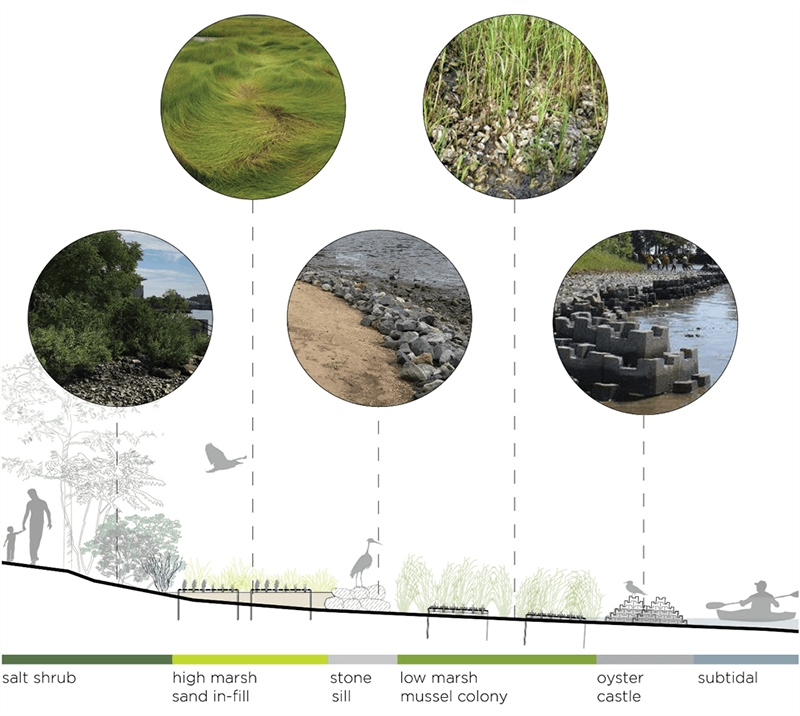
A future vision of the Swindler Cove living shoreline.
How about the economics? How does a living shoreline compare to other alternatives?
FR: I think our living shoreline is a model not necessarily for how it’s designed. We’re not saying “We did this, so you should do this, too.” It’s more about the process of the model, which is taking the time to analyze and observe what you have, understand what the problem is, and address that problem in the most ecologically sensitive and lightest footprint that you can, which is what we’ve tried to do.
JS: As Filomena noted, developing a citywide, resilient shoreline is going to require a mix of strategies. But really, I think what we are really concerned about is that we don’t see enough of the design process we’re taking here. We see almost none of it, actually, and it’s not because it’s more expensive. It’s because it’s not the way people are used to doing things, in addition to just being harder, so it’s it makes people uncomfortable. A significant portion of the resources that NYRP invested in this project was used for design and permitting, and a lot of that was due to the hurdles that are placed in front of doing a relatively unfamiliar project like this.
That’s why talking about it is so important to me, because we want to make it easier for other grassroots organizations, who we’re are in touch with all the time, and who are trying to restore little pieces of New York City’s shoreline. Because of the bureaucratic challenges though, are really unable to.
Luckily we have Filomena as a staff landscape architect able to help us, but one could do a project like this in some ways without a lot of expensive contractors and the materials are not insurmountable. We haven’t done a financial analysis on, acre to acre, how much this would cost versus what else we would have to do to protect Swindler Cove, which would be elevating the artificial rock shorelines and installing seawalls. But that would almost surely be more expensive.
All this considered, what motivated NYRP to install a living shoreline?
JS: I would say the primary goal for NYRP is to maintain a beautiful, healthy, useable park for the community. And that means a park where we can bring kids down and they can walk into the water and they can see the tidal change and ultimately interact with it.
Because of our living shoreline approach, we think Swindler Cove has gone from having a really bleak future where we were looking at really losing the remaining wetlands pretty quickly to a situation where we can see a really vibrant future with the park actually being healthier and full of wildlife.
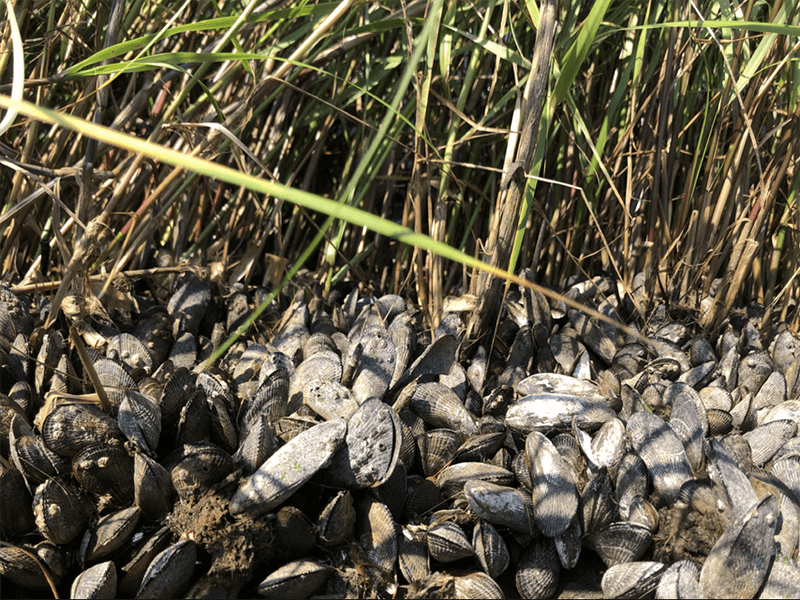
Ribbed mussels and spartina grass growing together.
Let’s talk about the individual elements of the living shoreline we’re installing at Swindler Cove. What are some notable components?
FR: One of the two main elements are the Oyster Castles, which is a brand name. Their primary function in our project is wave attenuation. In other words, they’re designed in a way that when the waves come in contact with them, the castles break the waves down. When the water goes through the castle to the shoreline, it’s not as intense of an impact.
Another reason why we chose Oyster Castles is because of how the concrete is formulated. It’s designed with a particular pH and it actually has embedded shells that are designed to facilitate the growth of bivalves and other water creatures.
The second main element is the marsh grass itself, which is actually working synergistically with the castles to protect the shoreline and create habitat. For the marsh plantings we’re using, we’re looking at sort of two different areas: the low marsh, which is the part of the marsh that gets inundated with water every day, and then the high marsh, which is sort of just above the normal high tide, and so just floods occasionally.
The ribbed mussels are also part of the low marsh habitat. They pair with the spartina grass plantings in the low marsh and have a symbiotic relationship. The mussels, because they’re bivalves, want to attach to something and the roots of the spartina are a great place. At the same time, the mussels are protecting the roots of the spartina, so they’re working together to create this cohesive and strong marsh that’s less vulnerable to erosion.
Those ribbed mussels came from Jamaica Bay, correct?
FR: Yeah. Initially the ones that were going to be introducing.
JS: Thinking about bivalves, our site in some ways it’s not ideal for oysters. We know that oysters are happy here and we’ve grown them on artificial oyster cages, but we think my mussels can also do a great deal to filter the water and possibly even more to aid the restoration of the marsh.
There is still a lot of interest right now in restoring oyster throughout the estuary, and justifiably so. But we think mussels can be a really important part of that conversation, too. There are a lot of sites where they may be actually more important and more useful than oysters. For example, our section of shoreline transitions from a shallow mudflat to a deep dredged shipping channel, leaving very limited opportunity for the creation of sub-tidal oyster reefs. Since mussels grow in the intertidal marshes, they are well suited to our site.
Introducing them is another example of how this project is really piloting a new process that’s not been done in parks. Filomena has worked really hard to find mussels because they’re not commonly used. Compared to oysters for example, there’s very little commercial availability a we’ve been lucky to partner with Baruch professor Chester Zarnoch who’s doing research on them all around the city.
He will provide some mussels for the initial installation as part of an experiment on our site to learn more about what role they might play and how helpful they are for nutrient cycling and the establishment of low marsh grasses. At the same time, we’re also looking at sourcing more mussels on a larger scale from commercial a hatchery.
I think the potential of using mussels and restoration throughout the city is really great. For our living shoreline to thrive, all of the elements, including mussels, will have to work together and rebuild an ecosystem that’s under a lot of stress. To date there’s been a mixed record of success in effectively establishing low marsh in the harbor, and if mussels can help with that, it’s going to be a really big deal.